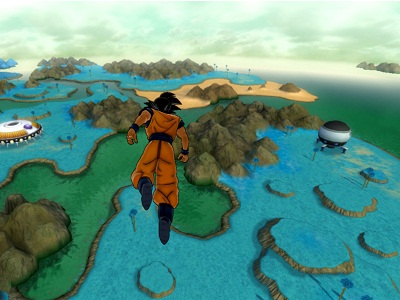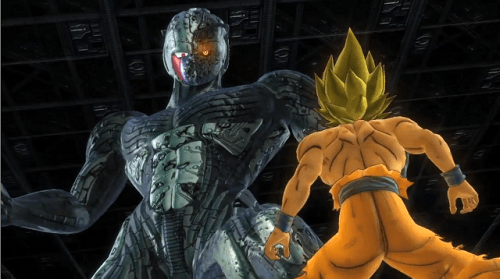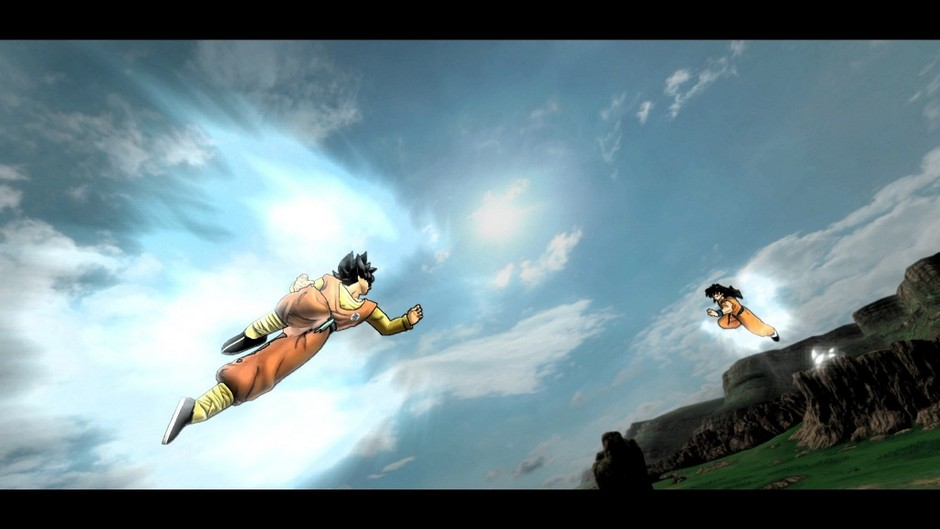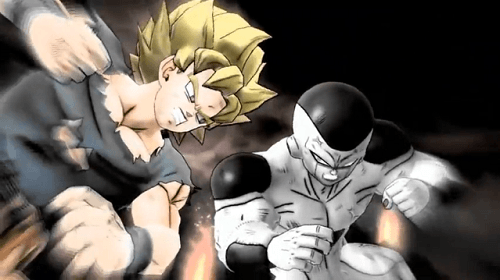Combat segments of the story are often divided up by free-roaming flight sections, which allows players, even in the story to explore the world where they can test out their character’s fighting abilities in casual fights with underling fighters and take part in the world martial arts championship to unlock new abilities, costumes and moves. When a player is ready to proceed, they may then head towards the marked objective on the free roam map to commence the next section of the story. (This free roam feature is also available in hero mode.) This facet of the game is actually surprisingly appealing. While I’m sure Vegeta never decided to stop by the world martial arts tournament on his way to fight Goku in the mountains, doing so provides a good opportunity for player to test out the abilities of their newly acquired characters before they head for the main event.
In Hero mode, this map roam time can also be used to train with some of the most famous DBZ fighters to learn their techniques and gain special traits and abilities off them. When the customised hero first starts out, there is no doubt that the player character is weak. It is only through training and entering combat with casual enemies that the player’s Saiyan warrior can gain strength, defence, energy, health etc. However, one disappointing thing about the Hero Mode I found was the severe limitation that the game offers in terms of creating a DBZ character. It would have been more accurate to advertise it as “create your own male Saiyan warrior”. What if we wanted to create an Android character? Wheat if we wanted to create a Namekian? What if we wanted a female lead character? All of these have been cut out from the customisation process, which is slightly disappointing, given how much potential it had. Additionally, most players will find that to customise their characters to the fullest extent, they need to both train and unlock extra clothing items, as the starting set is HUGELY limited.
Overall, the gameplay is not quite as solid as a fan would have hoped. To its credit, it is highly cinematic and easy to learn, but it quickly gets overwhelmed in a predictable cycle of fighting with little variance to keep the fun fresh. The issue that many players will find is that the fighting itself will be overwhelmed with a combination of repetitious cycles of attacks, the same combo cut-scenes for every character and horribly paced quick-time events. This also rings true of the boss battles. While the premise of fighting gigantic enemies as a boss battle is a very appealing one, the battles are overwhelmed with a repeating cycle of horribly timed quick time events and a process of dodge, hit, doge, hit. Despite the number of characters available to fight, up until the special attacks start being used, every character fights exactly the same way with hardly any variance. This is an unfortunate reality for a game that had the potential to be so much more. The gameplay is by no means broken, at is completely playable, but the experience feels somewhat stale after a number of plays. This reviewer recommends playing the game in short bursts for the best experience.
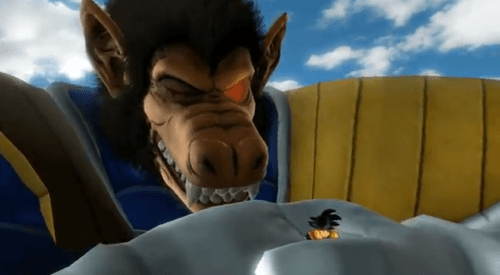
AUDIO / VISUAL
As far as the audio and visual are concerned, it is highly obvious that the game is attempting to interlink more so with the newly adapted Dragonball Z Kai anime than the anime original. The utilisation of newly rendered cut scenes and musical scores that mirror those of DBZ: Kai can be seen consistantly throughout. That said, the visuals are absolutely stunning in and out of gameplay, proving a highly cinematic feel to gameplay. The visual rendering of the characters is well defined, the environments large and elaborate in detail, and the special effects stunning. It truly feels like how an anime based game should appear. From the smallest scratch on the player’s clothing, to seeing a building fall under the pressure of several ki blasts, players will be able to see every detail of the battle that surrounds.
The audio segments of the game are more of a mixed bag. While the musical scores are highly appropriate for evoking emotional response from the audience, the voice acting work is more mixed. While some characters have retained their classic voice actors and styles, other have been changed and don’t sound quite like how one remembers them in the series. Gohan’s voice is especially confusing at times. There are also instances where the dubbing has been poorly translated from the Japanese originals to English. But overall the sound issues are nothing that break the game and only a minor criticism.
MULITPLAYER
What would a good fighting game be without good multiplayer? The game features a variety of game modes in which more than one player can interact. Standard battle mode allows players to use both stock DBZ characters, as well as the custom characters created in Hero Mode to do battle. Battles can be undertaken as strictly 1 on 1 affairs, but can also utilise the team battle, where players can switch with, and even fuse with other team members to assist the battle. For more than 2 players, gamers can choose the tournament mode which allows up to 16 player or computers to duke it out. But probably the coolest multiplayer feature is that which allows players to take their own customised fighter online to battle with other created characters. In doing so, players should be prepared to face off against some very cool, and VERY tough opponents.
CONCLUSIONS
My initial opinions of DBZ:UT were difficult to place. When I began playing it, I wasn’t entirely sure whether I was enjoying it or not. The fact of the matter is that as the game lends itself to a fighting genre, then one will often find themselves drawing comparisons between this outing, as well as that of previous titles. In the end it comes down to a matter of personal taste. A significant divide exists between DBZ fans who prefer the arcade, locked style of fighting displayed in the Budokai games and Burst Limit, while others prefer the free roam combat, such as that displayed in the Tenkaichi games and in the Raging Blast series. I myself am more fond of the former, but DBZ: Ultimate Tenkaichi lends itself more strongly to the latter. This is not to say that it is a bad game by any means. In fact, the stunning visual design provides a HIGHLY cinematic feel to gameplay, and the pacing makes fighting feel just as intense as the anime itself. It will simply come down to a matter of personal preference. If you’re fond of games in the fighting genre like Soul Calibur, DOA and Tekken, then DBZ: UT will probably seem like very foreign and awkward territory. But for fans of previous Tenkaichi and Raging Blast games, then you will most certainly enjoy this newest instalment.



